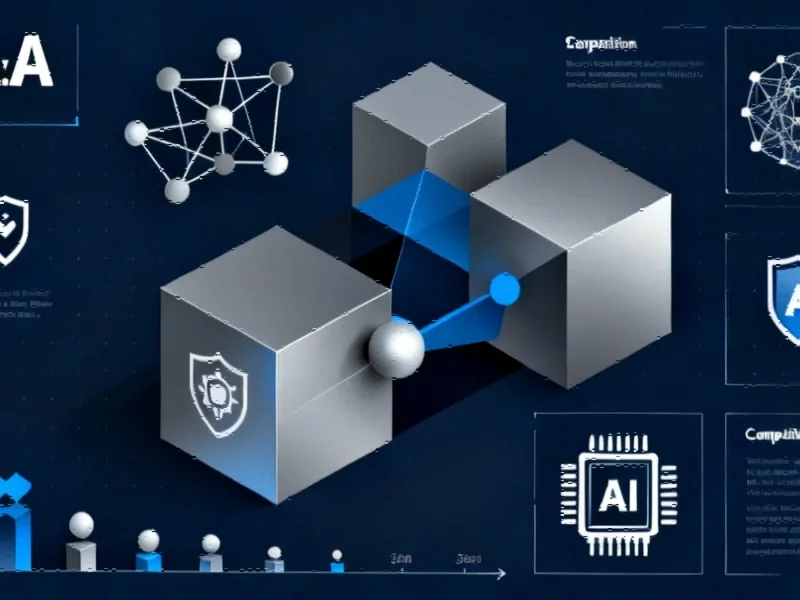The Era of Cybersecurity Giants
The cybersecurity landscape is undergoing a seismic transformation in 2025, marked by unprecedented consolidation through both blockbuster acquisitions and strategic startup purchases. This dual-track approach to mergers and acquisitions reflects how security providers are responding to increasingly sophisticated threats and the rapid integration of artificial intelligence across digital infrastructure. The industry’s evolution toward larger, more comprehensive security platforms represents a fundamental shift in how organizations will approach digital protection in the coming decade.
According to industry analysts, this consolidation wave signals the cybersecurity sector’s maturation into a critical infrastructure component rather than merely a technology niche. As Neil MacDonald, vice president and distinguished analyst at Gartner, noted: “This is becoming a battle of well-funded, large competitors.” The emergence of these security behemoths creates both opportunities and challenges for the broader ecosystem, potentially raising barriers to entry while simultaneously driving innovation through increased investment.
Mega-Deals Reshape the Competitive Landscape
The cybersecurity industry witnessed two landmark transactions that redefined market dynamics in 2025. Google’s $32 billion acquisition of Wiz in March marked the largest security deal in history, signaling the tech giant’s serious commitment to dominating the cloud security space. This was followed by Palo Alto Networks’ $25 billion purchase of CyberArk in July, creating an identity security powerhouse with unprecedented market reach.
These transactions represent more than just financial milestones—they illustrate how established security leaders are willing to make bold moves to secure their positions in an increasingly competitive market. Both deals involved companies that had previously been active acquirers but never at this scale, suggesting a new phase in the industry’s development where comprehensive platform offerings may eclipse best-of-breed point solutions.
For context on how these developments fit into broader market trends, industry observers point to the convergence of several factors driving this consolidation wave.
The Startup Acquisition Spree Continues
While the blockbuster deals captured headlines, 2025 has also seen an acceleration in acquisitions of innovative security startups by established players. Companies including CrowdStrike, SentinelOne, Check Point, and Tenable have all made multiple strategic purchases this year, focusing particularly on AI-driven security technologies and specialized capabilities that complement their existing platforms.
This parallel trend of startup acquisitions serves multiple strategic purposes for established vendors:
- Technology acceleration: Buying rather than building allows faster integration of cutting-edge capabilities
- Talent acquisition: Access to specialized expertise in areas like AI security and threat intelligence
- Market positioning: Strengthening competitive positioning in high-growth segments
- Innovation injection: Infusing established organizations with entrepreneurial energy and fresh perspectives
The focus on AI-related security startups has been particularly pronounced, reflecting the industry’s urgent need to address both the defensive applications of artificial intelligence and the novel threats emerging from AI adoption. This aligns with broader industry developments in artificial intelligence investment and innovation.
Strategic Drivers Behind the Acquisition Frenzy
Several converging factors have created the perfect conditions for accelerated cybersecurity M&A activity in 2025. The escalating sophistication of cyber threats, combined with the transformative impact of generative AI, has created both urgency and opportunity for security providers. Organizations are increasingly seeking comprehensive security platforms rather than managing dozens of point solutions, driving vendors toward consolidation to meet this demand.
Additionally, the growing complexity of digital infrastructure—spanning cloud, hybrid, and edge environments—has created pressure for security solutions that can provide unified visibility and control. This technological evolution, including emerging standards like those highlighted in recent technology innovations, underscores the need for integrated security approaches.
The economic environment has also played a role, with valuation adjustments for some private security companies making acquisitions more attractive for well-funded public companies and private equity firms. Meanwhile, the ongoing shortage of cybersecurity talent has made acquisitions an increasingly important channel for accessing specialized expertise.
Impact on the Cybersecurity Ecosystem
This wave of consolidation creates both opportunities and challenges across the cybersecurity landscape. For enterprise customers, the emergence of larger, more comprehensive security platforms may simplify vendor management and improve integration, but could also reduce bargaining power and choice. For smaller security vendors, the environment presents a clearer path to exit but potentially greater challenges in competing for enterprise attention and budgets.
The consolidation trend also intersects with other market trends in digital infrastructure and connectivity, as security becomes increasingly intertwined with network performance and reliability.
Looking ahead, industry experts anticipate several potential developments:
- Continued consolidation in fragmented security segments like cloud security posture management and application security
- Increased cross-border M&A as geographic expansion becomes a priority for global security providers
- Private equity involvement in larger deals as financial sponsors recognize the defensive characteristics of cybersecurity
- Regulatory scrutiny potentially increasing as security market concentration grows
The Future of Cybersecurity Innovation
While consolidation often raises concerns about innovation, the cybersecurity industry’s unique dynamics may mitigate this risk. The constantly evolving threat landscape ensures that new challenges will continue to emerge, creating opportunities for specialized vendors. Additionally, the open nature of many security technologies and standards facilitates integration and interoperability even as market concentration increases.
The parallel trends of mega-deals and startup acquisitions suggest a bifurcated future for the cybersecurity market: a handful of comprehensive platform providers serving broad enterprise needs, alongside specialized innovators addressing specific threats or technologies. This ecosystem approach to security reflects the broader evolution of enterprise technology, as seen in related innovations across the technology sector.
As the cybersecurity industry navigates this period of rapid transformation, the ultimate measure of success will be whether these consolidated entities can deliver more effective protection against increasingly sophisticated threats while maintaining the innovation velocity that has characterized the security sector for decades.
This article aggregates information from publicly available sources. All trademarks and copyrights belong to their respective owners.
Note: Featured image is for illustrative purposes only and does not represent any specific product, service, or entity mentioned in this article.



